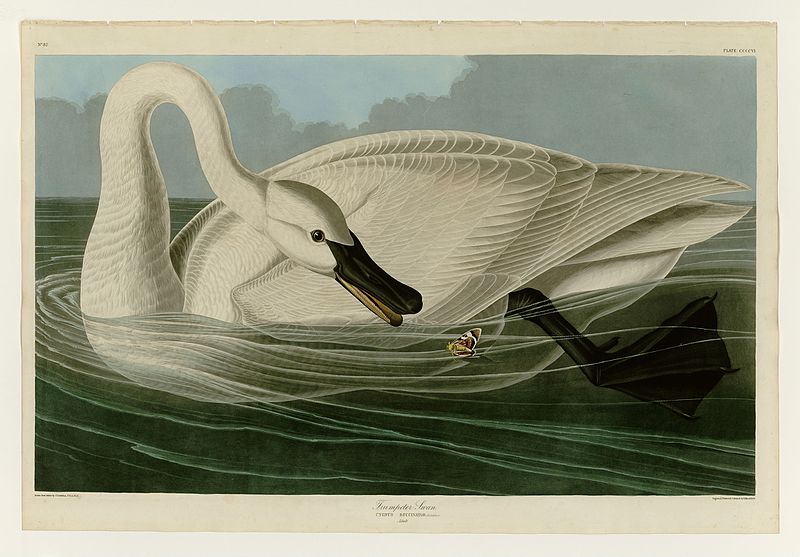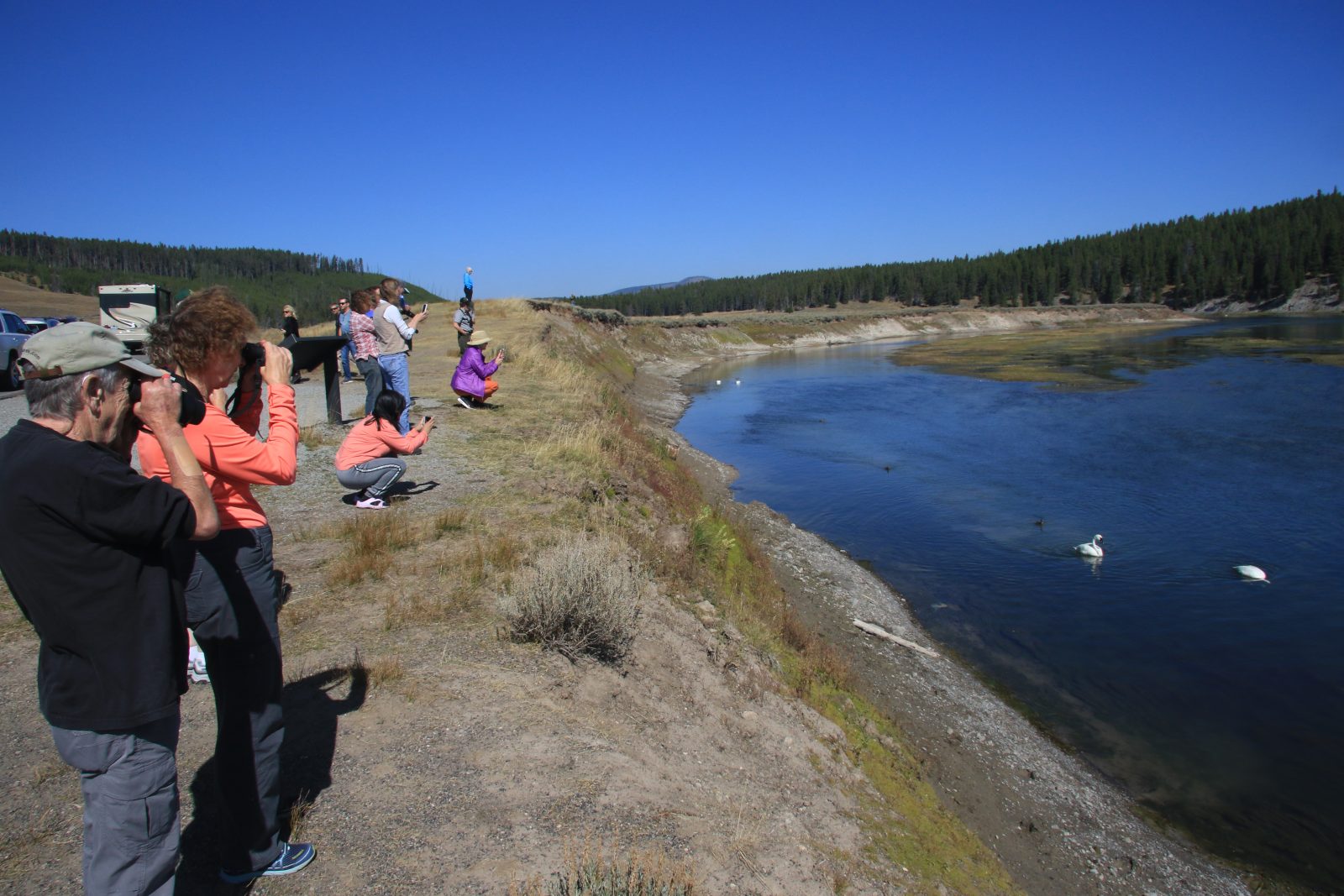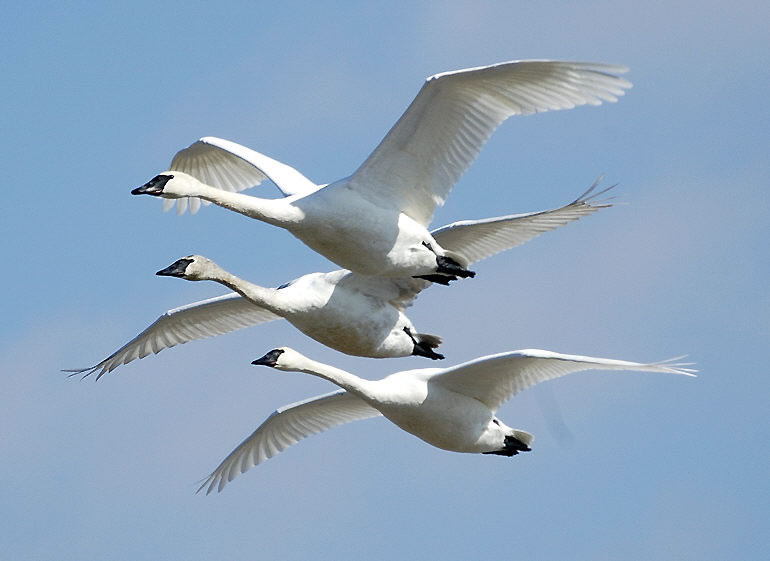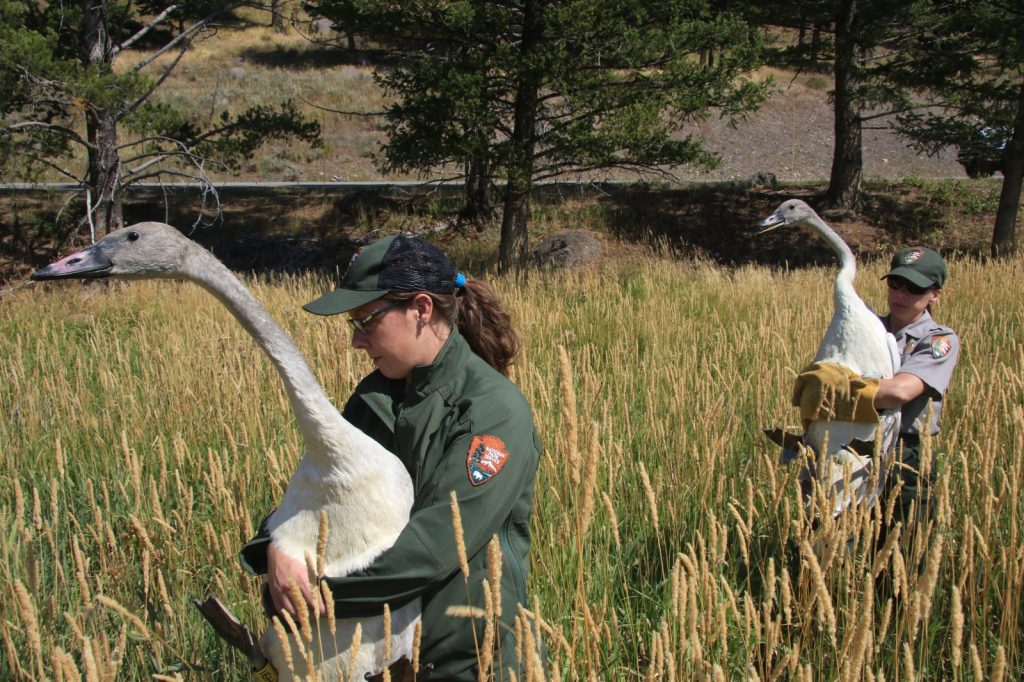In the early 1900s, when people were driving any birds with attractive plumage to extinction, a small group of trumpeter swans persisted, tucked away in a hidden corner of the U.S.
They had been killed off nearly everywhere else. Hunters wanted their meat. Women’s hat and clothing manufacturers wanted their striking white feathers.
But in Yellowstone National Park, the nearby Red Rock Lakes National Wildlife Refuge and surrounding region, about 70 birds remained. Now in a twist of ecological fate, what was once one of the last reservoirs of trumpeter swans in the lower 48 may blink out.
“I think it’s on one hand tragic and the other hand sad because you are losing a native species that used to do extremely well in Yellowstone,” says Doug Smith, senior wildlife biologist with Yellowstone National Park. “I get you can’t preserve vignettes of primitive nature forever because systems are constantly changing, but swans have been a vital part of the ecosystem.”
Smith has been tracking trumpeter swans in the Park since he was assigned the duty in 2008. They’re not his only charge – he was the lead biologist when grey wolves were reintroduced, he’s watched as grizzly bears have made a comeback, and he’s helped track epic elk migrations — but of the megafauna he studies and manages, the trumpeter swan is one of the most iconic, easiest to see and longest documented (records go back in the Park to 1917).
It’s also one of the most imperiled.
Only two breeding pairs exist in the Park now, and their finicky nature means many years they may simply choose not to reproduce, and they haven’t in the last two years.
“Right now, we’re not sure why swans are doing poorly,” Smith said. “We have some good ideas, but we can’t say it definitively. If we learn that Yellowstone has changed so much it’s no longer swan habitat, we have to bite the bullet and understand that.”
The Last Reserve
Like grizzly bears and bison, swans’ longevity in Yellowstone National Park was largely a product of its protected status. The Park was established in 1872 to protect its soaring geysers, psychedelic hot springs and complex thermal features. As a side effect, the wildlife in the park was also preserved.

Red Rock Lakes was set aside as a swan refuge in the 1930s, when officials realized it was one of the few remaining locations with the massive birds.
Once the country decided it was time to stop hunting swans and start protecting them – in the 1960s – about only a few thousand remained across the continent, according to the Trumpeter Swan Society. Outside of Yellowstone, Red Rock Lakes and a few other refuges, the rest lived in remote portions of Alaska and Canada.
Swans and their eggs were used to try to restore populations in the West as early as the late 1930s and 1940s. In the mid-1960s, reintroduction programs began in Minnesota, and by the 1980s and 1990s, they were being restored in earnest throughout portions of the Midwest and Rocky Mountains.
Some of the relocations have been successful, such as the Upper Green River area in southwest Wyoming which now has more than 25 breeding pairs of swans.
It’s considered an expansion area, a possible connection between Yellowstone at the farthest north, the Snake River population near Jackson, Wyoming and south to Green River, says Susan Patla, nongame biologist for the Wyoming Game and Fish Department.
But the Snake River population is still small – about nine breeding pairs – and faces competition for food from Canadian and Alaskan birds that come down to the warmer springs to winter.
“When you look at the total number of young, we had 43 young produced in the Green River compared to 14 in the Snake River,” Patla says. “If we didn’t have a range expansion program I would be much more worried about the Snake.”
About 60,000 swans exist throughout North America now, mostly centered in Alaska, the Rocky Mountains and the Midwest.
But back in Yellowstone, the place that kept the species alive, the birds are struggling.
“If you graph the swan population, each year it’s increasing or stable from ‘30s to the ‘60s,” Smith says. “In the ‘60s, the line starts to dip down and in the early ‘90s, it dips down steeper.”
Humans Predators and Climate Change
Why, exactly, swans in Yellowstone are suffering is largely open for debate among biologists. But most wildlife managers have narrowed it down to three likely suspects: eagle predation, human disturbance and climate change.

Eagle predation, which seems like the most natural impact on swans, is also a product of humans. Lake trout were illegally introduced into the Yellowstone ecosystem and eviscerated the native cutthroat population, meaning instead of feeding on thousands of cutthroats, eagles are targeting other food such as swan babies.
And their impact is exacerbated by human disturbance.
“People see the swans and walk to them and say, ‘Isn’t that cool, it’s a swan.’ The swans go ‘oh sh–,’ and they swim out into open water (away from protective cover on the shore) and the eagles dive bomb their young. I’ve seen it from the air.”
When a swan pair produces only two or three young every year, losing a portion takes a quick toll on the population.
The other main issue is climate change, which is creating colder, wetter springs and drier wetlands in the fall. Both of which kill swans.
“Almost their entire diet is submerged aquatic vegetation, not like geese that will also eat Kentucky blue grass,” says Patla. “A family of two to raise four cygnets to flight takes 3 to 5 tons of vegetation.”
As wetlands dry in the summer and fall, so does the food.
Variable weather in the spring also can kill cygnets.
“Our two territories have not had young either year because their Achilles heel, what they don’t like, are cool wet springs. We’ve had two cool wet springs in a row,” says Smith. “It seems counterintuitive: How do you have cool wet springs due to climate change and wetland reduction due to climate change, but we do. Once summer hits it doesn’t rain.”
A Case for Intervention
By 2010, only eight swans remained in Yellowstone, and Park Service officials had two options: supplement the population with more swans or let the species go.
“We intervened, and the reason we intervened is because until you can identify the direct cause, we don’t want to lose swans. And two, if the cause is human, we can intervene.”
Since the likely causes are eagle predation – which was ultimately a product of humans introducing lake trout – human disturbance and climate change, the Park Service felt like it could begin bringing swans in to supplement the population.

Now about 25 individuals live in the park, but there are still only two breeding pairs.
Service officials have closed access to one of the nesting sites throughout the summer to prevent human disturbance. Swans at the other site are more accustomed to people, Smith says, and eagles aren’t nesting nearby.
But now biologists like Smith wonder if the population can ever be sustained again without human intervention, which is another ethical dilemma.
“It’s relatively cheap, and so you could keep bringing swans in. But fundamentally, the National Park Service is about natural processes, about letting nature take care of itself, reducing the impacts of humans and letting those natural processes occur on their own. Artificially augmenting the swan population indefinitely goes against that philosophy. Look at wolves. We reintroduced them for two years and they’re on their own in perpetuity.”
Swans will likely persist in other parts of the country, say biologists like Patla. The Green River population in Wyoming has plateaued, but is still strong.
Whether or not they can continue to exist in Yellowstone is still a matter for debate. Smith and others will keep trying fixes like building floating nests to prevent them from being flooded, continue reducing human impacts and reintroduce birds – the Service just released eight swans in early September.
“We would enjoy Yellowstone less to lose this magnificent beautiful bird that was once so common. It would be a less interesting and enjoyable world, not to mention ecologically we would lose a key component of the ecosystem,” says Smith.
“Some would say you can’t keep everything the same forever, and good point, but we’re humans, and it’s up to us.”




Beautiful, heart wrenching narration of the acts that are impacting nature in many locations globally. Very concise with non-judgemental journalistic clarity! Much to do! Little time to decide what.
This is so tragic. The trumpeters are magnificent. We do not have them here on the Saint Lawrence river as far as I know, but I have noticed a decline in the swans here. I began walking near a specific area 9 years ago where up to 30 swans gathered. Now I may see six. I’m hoping they moved to more hospitable waters, but your article worries me.
The more variables, the harder it is to solve a question. Testing each variable under controlled conditions in the laboratory of nature is very difficult. The answer to the question why the swans are not able to produce at a rate to sustain or increase its population may never be solved just as scientists have never explained the extinction of the wholly mammoth .
Why do humans have to mess everything up??? Then it takes more humans to try and make it right!!! And who suffers, the animals and the environment…
Well, actually, since people are historically not natural to the area, except for originally ,small tribes of indigenous people, then by allowing tourists in the park, you have already intervened in the natural processes of nature. That being said,you might as well keep introducing more swans. Don’t beat yourself up over it. If not that, then close the park, not something I would want to have happen.
Interesting article. I shared it with the 36k members of the Facebook group “Yellowstone Up close and personal”.
Thank you, thank you for writing about this issue.
Thank you to those involved in sustaining this population — their concern and the action they are taking.
Thanks so much for such an informative article, you’ve done great research.
One question I have is how were the lake trout (what specie is this?) introduced ?
Do these lake trout feed on the cutthroat? I’m a believer in climate change, but it is odd that the cooler, wet springs (two years seems a small sample) and dryer summers are the cause for less breeding.
Do the swans sense ahead of time there will be no food (due to dry wetlands)?
Keep up the great work!
~Ken
Hi Ken,
Thanks for your questions and glad you enjoyed the story. Lake trout (Salvelinus namaycush) were first noted in Yellowstone Lake in 1994. They have long believed to be an intentional but illegal introduction by someone with a bucket, although some recent sources call this to question. There are non-native lake trout in other area lakes, and some believe they could have been moved from one lake to another by predatory birds. Whatever the case, they have proliferated. You can read more detailed info on the lake trout introduction, how they have affected cutthroat and more here: https://blog.nature.org/2016/08/24/why-gill-nets-lake-yellowstone-cutthroat-trout-invasive-fish/
As far as climactic impacts on the swans, I don’t have an immediate answer and have not seen any literature on this.
Thanks again for your comment.
Matt Miller
Cool Green Science editor
Please Try To Protect This Beautiful Species So They May Flourish In Yellowstone Once Again.
Tell NO ONE Where They Are…
All Foreign “Invaders”, To the Natural Habitat Of Yellowstone and Surrounding Area, Should Be Banned From Farming/Agriculture/Sheep and Cattle Raising …
They Too, Are Causing The Demise Of Our Wildlife
PLEASE Provide/Protect Habitat For All Wildlife To Thrive…..
Well, it seems obvious to me, considering what has been observed by air, that it’s time to temporarily stop allowing tourists to observe them at close range. The swans have made a pretty clear statement about how they feel by quickly moving away from all the cameras, phones and two legged featherless creatures.
Isn’t it worth trying ?
Thanks,
Mary Curro
Portsmouth, VA
I have a question about the photo at the start of the article: How do the people carrying the swans get the swans to cooperate? I was always told that swans were very aggressive, and if you got within bighting distance you would get bit! Have I been misinformed all these years, or is some other factor involved, such as the swans being tranquilized, or accustomed to those particular handlers?
I shared the article on Facebook
I live in the Mission Valley in Montana close to the National Wildlife Refuge. We have several breeding pairs of Trumpeter Swans living there. When I lived in Washington State, the migrating swans always stopped by the fields in the Mount Vernon area. They are a beautiful sight to behold
thats sad to hear i hope that we can bring the swans back and stop the destruction of yellow stone park from the destructive nature of trump and his followers,
maybe we can find a more secluded spot so that they arent disturbed by humans
This report is far beyond alarming. With all of the decisions our government has been and continue to make to destroy these and other wonderful animals. We know we can’t save everything but we can save many from extinction.